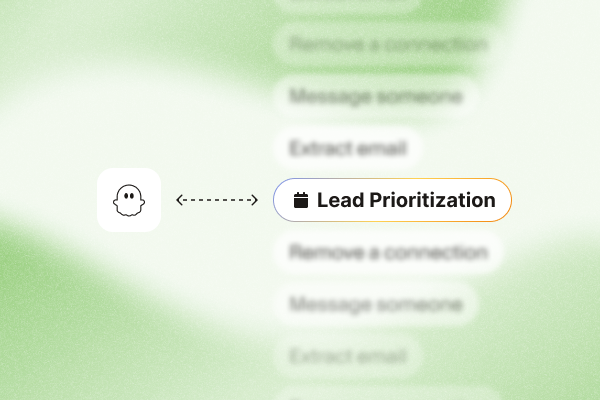Every minute spent on high-quality leads is a step closer to your next closed deal.
Your pipeline stays fresh, high-value opportunities stand out, and your team stays motivated.
In this guide, you’ll learn exactly how to identify, score, and enrich your leads so you can focus your efforts where they matter most and close more deals.
AI highlights
- Lead prioritization is the process of ranking prospects based on their likelihood to buy so your sales team can focus on the most valuable opportunities first.
- Successful lead prioritization relies on a lead scoring system, intent signals, and ICP score.
| Technique | Description (What It Does & How) | Tool |
| Use lead scoring | Rank leads based on conversion likelihood by applying CRM data’s positive, negative, and behavioral criteria. See lead scoring best practices. | PhantomBuster’s AI LinkedIn Profile Enricher |
| Identify intent signals | Track prospects’ buying intent through specific actions like pricing page visits, webinar attendance, and competitor engagement. | PhantomBuster’s LinkedIn Post Commenters and Likers automation |
| Find | Extract engaged LinkedIn users who interact with relevant posts or competitor content to prioritize based on intent quickly. | PhantomBuster’s LinkedIn Post Commenter and Liker Scraper |
| AI-driven | Automatically qualify and score leads based on ICP criteria (job title, company size, location, industry, skills, competitor mentions). | PhantomBuster AI LinkedIn Profile Enricher |
- Leverage PhantomBuster’s automation tools to streamline lead scoring, enrichment, and ICP matching, freeing your team to focus on closing deals. Start your free trial today!
Use a lead scoring system to identify qualified leads
Lead quality is crucial for the success of B2B marketing and sales teams. Poor lead quality is one of the top complaints from 42% of sales reps handling inbound leads. The solution? Lead scoring.
It involves ranking your leads based on their likelihood of conversion and assigning points to prospects based on criteria such as company size, industry, engagement level, and buying signals. Understand the difference between a prospect and a lead here.
Whether it’s inbound or outbound leads, calculating these scores based on data in your CRM will help you understand how to nurture them effectively and convert them into buyers.
How to use HubSpot for lead scoring
HubSpot provides a native lead scoring feature that lets you set criteria and assign specific scores based on lead engagement and fit. It then automatically assigns scores using prospect behaviors, engagement levels, and demographic fit.
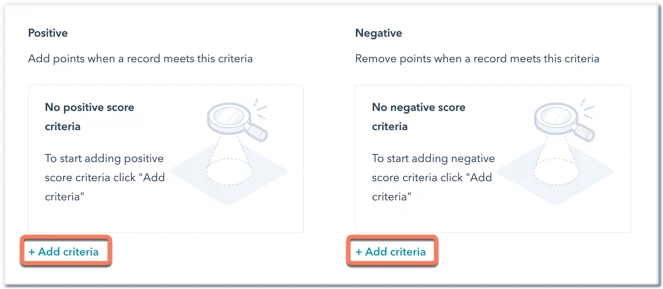
When leads hit certain score thresholds, you can use HubSpot to trigger automated actions like notifying sales reps, sending targeted emails, or moving prospects through the sales pipeline.
This allows your team to focus its efforts on high-value opportunities efficiently.
Prioritize leads based on intent signals
Not all leads intend to buy. Intent data is like digital body language—the online equivalent of someone leaning forward during your presentation.
Signals include marketing activities like pricing page visits, webinar attendance, and demo requests, as well as sales activities like prospects interacting with competitor content on LinkedIn.
By noticing buying signals, your sales team can reach hot leads at the perfect moment when they’re most interested and ready. This leads to better conversations, faster sales, and more conversions. Consider exploring intent data providers to enhance this.
How to add and prioritize warm leads into your sales pipeline
To fill your sales pipeline with warm leads, identify prospects who demonstrate intent. LinkedIn posts are particularly valuable.
When someone comments on a competitor’s post, it’s like they’ve raised their hand and say, “I’m interested in this topic.” These hot leads convert to paying customers at 3- 5x the rate of cold prospects.
We recommend using a tool like LinkedIn Post Commenters and Likers automation to instantly collect leads from people who’ve engaged with your posts or even your competitors’ posts.
When you run the automation, you’ll get a prospect list, including their comments and LinkedIn profile URL, ready to export to a CSV, enrich further, or contact using LinkedIn outreach strategies.
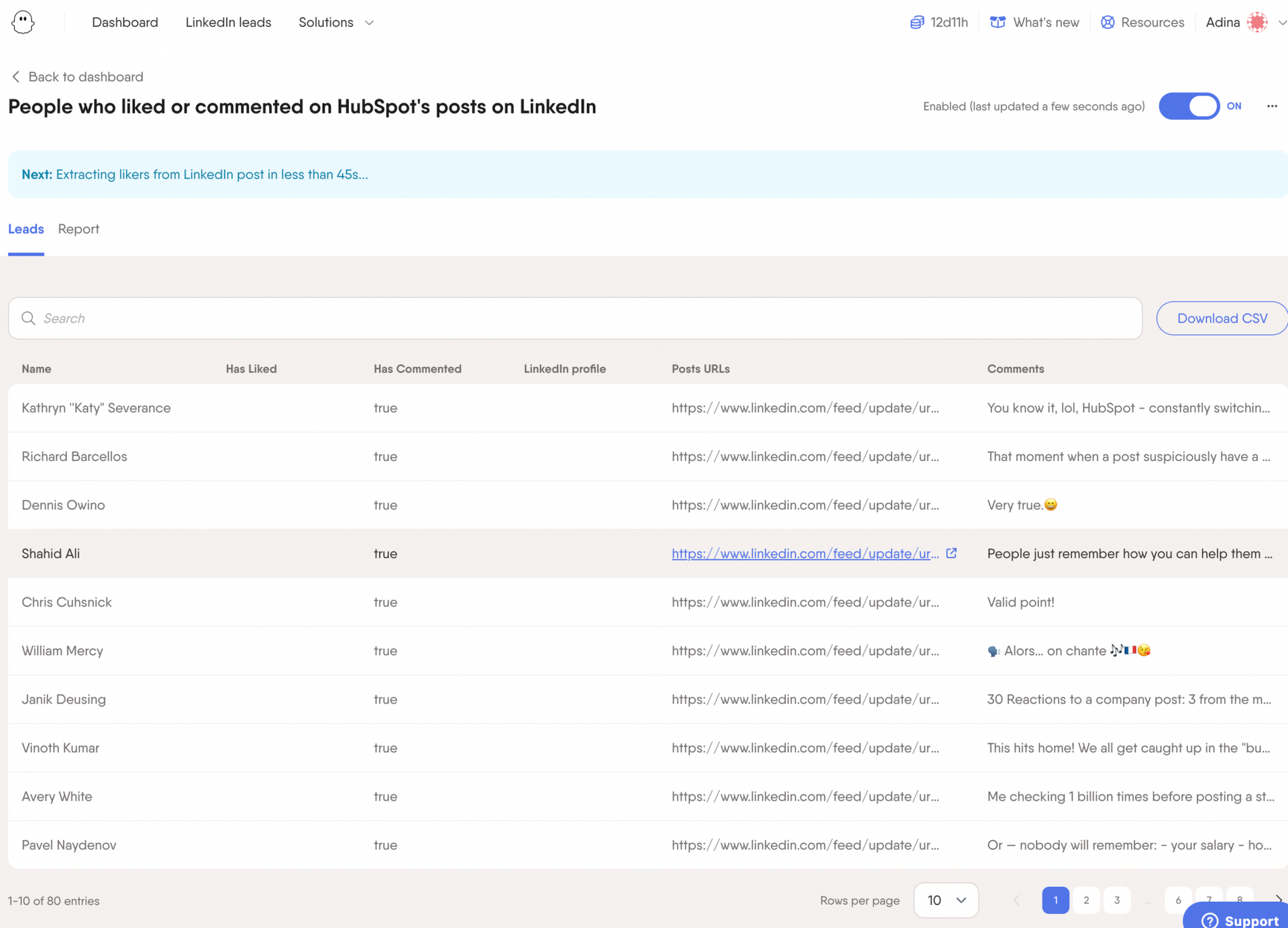
Once the list is created, you can sync the data into HubSpot to send LinkedIn data directly to your customer relationship management tool. Hence, you have the most accurate data for AI lead scoring at all times.
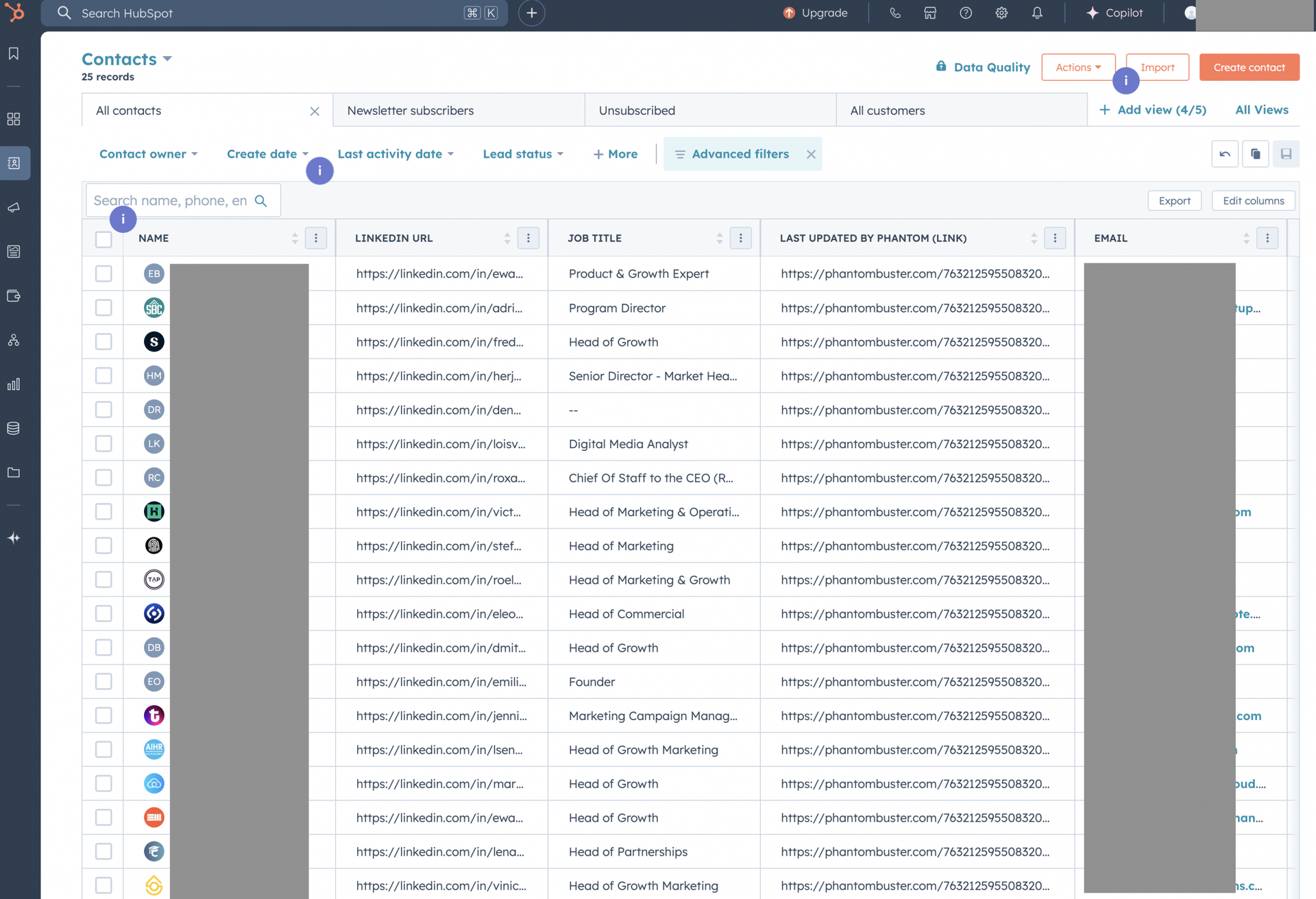
Prioritize outbound and inbound leads based on your ICP match
Qualifying leads starts with prioritizing those who match your Ideal Customer Profile (ICP). Instead of chasing inbound leads that aren’t a fit or outbound prospects unlikely to convert, your sales team can focus on those that match your target audience.
To accurately qualify leads against your ICP, start by collecting data on key attributes such as industry, company size, budget, role seniority, and technology stack using data enrichment tools.
How to use AI to qualify leads based on your ICP
First, map out the leads you’ve collected from LinkedIn or other prospecting tools. For example, using the Sales Navigator List export, you can export your saved leads or accounts lists from Sales Navigator into a spreadsheet in just a few easy steps.
Next, use an AI tool to automatically qualify those leads based on your Ideal Customer Profile (ICP).
For example, PhantomBuster’s AI LinkedIn Profile Enricher simplifies this step.
Here’s how it works:
Start by writing a clear prompt that tells the AI exactly how to qualify each lead. Your prompt should include the job title, company size, industry, or location. The AI then analyzes each LinkedIn profile and scores your leads accordingly.
Here’s an example:
Analyze each LinkedIn profile in the provided list. Assign a lead score from 1 to 5 (5 being the highest) based on the likelihood of them being a good prospect for a sales automation platform.
Consider these factors:
Job Title: Give higher scores to profiles with titles like “Sales Director,” “VP of Sales,” “Head of Sales,” or “Sales Operations Manager.” Give lower scores to titles like “Sales Intern” or “Account Executive.”
Industry: Prioritize profiles of those who work at SaaS companies.
Company Size (from the LinkedIn Company Page): Favor companies with 50-500 employees.
Location: Prioritize profiles located in North America.
Skills: If skills include sales, automation, and similar, increase the score.
Mentions of Competitors/Relevant Topics: If the profile text (summary, experience descriptions) mentions competitors (e.g., “HubSpot,” “Salesforce,” “Pipedrive“) or relevant topics (e.g., “sales automation,” “lead generation,” “pipeline management“), increase the score.
Return the lead score in a new column.
Once done, you’ll get an overview of the enriched leads in your list and their scores.
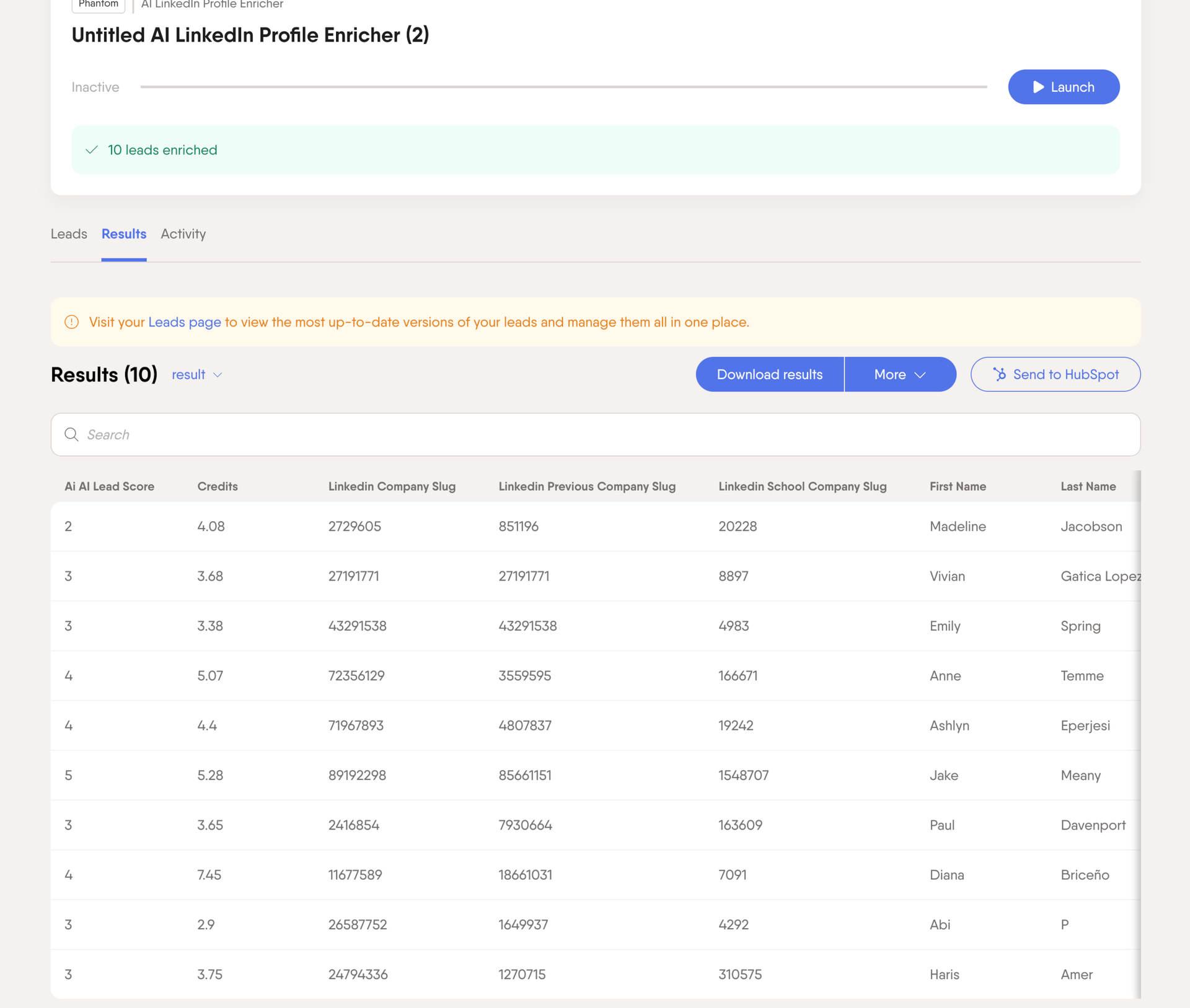
You can then prioritize each lead based on the given score.
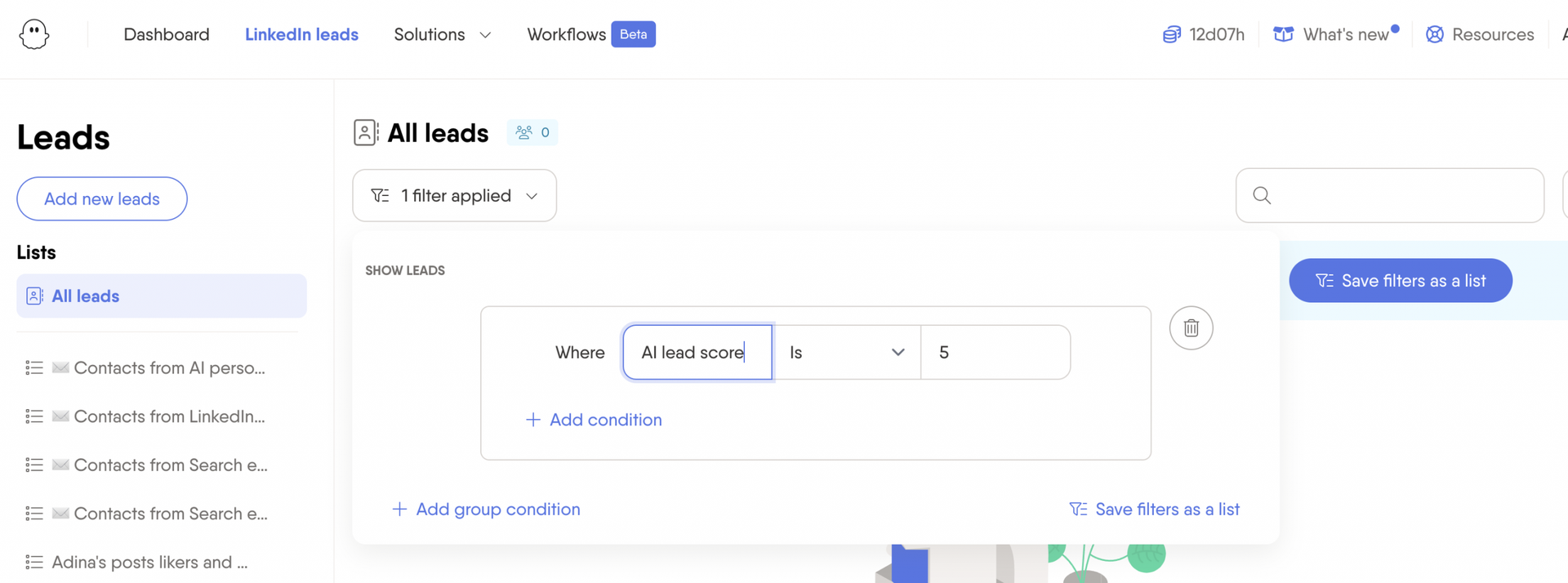
Top challenges in lead prioritization across the sales funnel
Here are some challenges faced by the sales team during lead prioritization:
- Challenge #1: Unclear ICP criteria: Clearly define your ideal prospects (industry, company size, location) to identify and disqualify poor-fit leads. Learn how to define your ICP for sales.
- Challenge #2: No defined lead scoring system: Set clear scoring rules based on ICP alignment, intent signals, and engagement levels to prioritize qualified leads faster.
- Challenge #3: Misalignment between sales and marketing: Create shared criteria for lead qualification and regularly review together to speed up sales cycles and avoid missed opportunities.
- Challenge #4: Ignoring intent signals: Include key buying signals (pricing page visits, demo requests, content downloads) in your scoring system to pinpoint prospects ready to buy.
- Challenge #5: Data overload: Limit data collection to standardized, ICP-focused attributes, simplifying decisions and preventing overwhelm. Avoid dirty data issues.
How to use automation to prioritize leads in your sales pipeline
Automating lead data collection, enrichment, and scoring helps your sales reps quickly identify high-quality prospects, making it easier to nurture leads and accelerate deals. Explore lead automation techniques.
| What to automate | Description | Best tool |
| ICP matching | Score leads based on ICP criteria like industry, role, and company size. | PhantomBuster’s AI LinkedIn Enricher |
| Lead enrichment | Enrich prospect data with lead enrichment tools and add details like role, contact information, and company revenue. | PhantomBuster’s LinkedIn Profile Scraper |
| CRM integration | Auto-update your CRM based on each lead activity, engagement, and intent signal. See options for CRM data enrichment. | PhantomBuster and HubSpot integration, HubSpot and LinkedIn Sales Navigator integration |
| Lead scoring | Prioritize leads based on customer data when interacting with a business to create a score indicating their likelihood of converting. | PhantomBuster, HubSpot. |
Lead prioritization FAQs
What is lead prioritization?
Lead prioritization is the process of ranking leads based on their likelihood to convert, considering factors like intent signals, ICP alignment, and engagement level.
This helps you rank leads based on their readiness to buy, yielding outcomes for your lead generation efforts. Your team constantly pursues prospects most likely to buy, no matter where or how they first engaged.
Why is it important to prioritize sales leads?
Your sales team has limited time, so it’s important to maximize its time on high-value leads. Here are more benefits.
- Improved efficiency: It helps you spend more time on high-potential leads that convert easily.
- Higher conversion rates: It helps you target leads most likely to convert, boosting your overall sales performance.
- Better resource allocation: It helps you allocate marketing and sales resources effectively toward the most valuable opportunities.
- Shortened sales cycle: It helps you close deals faster by identifying and engaging qualified leads early. Improve your pipeline velocity.
How can lead scoring help you prioritize the most promising leads?
Lead scoring helps your sales reps quickly identify the best prospects by assigning points based on profile and behavior. It focuses your team on high-potential leads using these factors.
- Demographics: Job title, role, seniority, decision-making authority.
- Engagement level: Website visits, content downloads, webinar attendance.
- Buying intent: Pricing page visits, demo requests, trial sign-ups.
- Email & call interactions: Email open rates, reply rates, meetings scheduled.
- Social engagement: LinkedIn profile views, post interactions, competitor content engagement.
- Historical sales sata: Similar to previously closed-won customers.
How to use lead scoring to prioritize leads effectively?
- Define scoring criteria: Identify attributes or behaviors that show high lead potential (e.g., job title, pricing page visits, demo requests).
- Assign point values: Give each criterion points based on importance. For example, a demo request gets more points than a webinar registration.
- Automate your scoring: Use tools like PhantomBuster, HubSpot, or Lavender.ai to track interactions and update scores.
Lead scoring criteria examples
Lead scoring ranks prospects based on key factors to identify high-quality leads. Common criteria include:
| Type | Criteria |
| Intent signals | Pricing page views, demo requests, form submissions, case study downloads |
| Demographics | Job title, department, job role, decision-making power |
| Firmographics | Company size, industry, revenue, location |
| Negative criteria | Wrong industry, low company revenue, irrelevant job titles |
Automated vs manual lead prioritization
Manual lead prioritization involves manually reviewing and organizing leads, often through spreadsheets. Automation simplifies this by automatically scoring, enriching, and organizing leads for you. Learn about automated sales prospecting.
| Automated lead prioritization | Manual lead prioritization |
| Quick lead scoring without spreadsheets | Slow lead scoring requires manual review |
| Uses AI to qualify leads | Usually based on guesswork and a manual spreadsheet |
| Handles large volumes of leads | Limited by human capacity |
